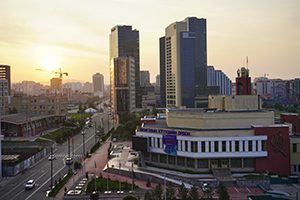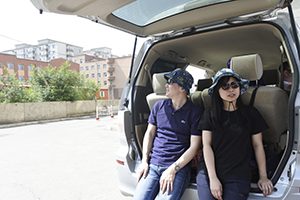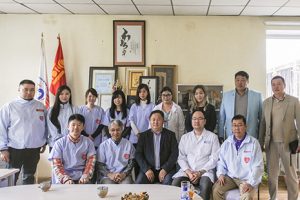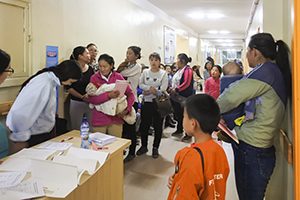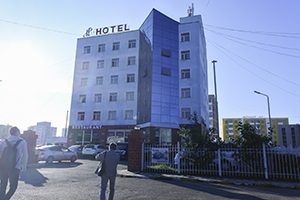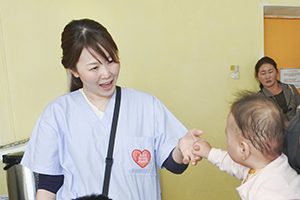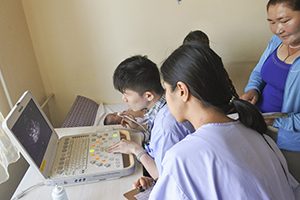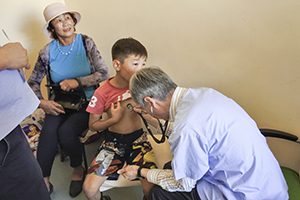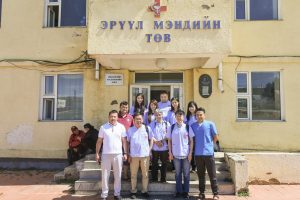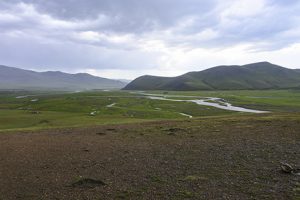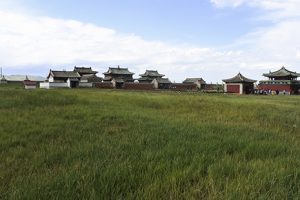Local Examination at Uvurkhangai,Mongolia in August 2019
1/27/2020
The following is a report from Dr. Masamichi Tamura, Director of the Project who participated in the local medical examination activities in Uvurkhangai Province among the two local medical check-up activities conducted in August 2019, Mongolia.
Pediatric Cardiology Examination Activity Report in Uvurkhangai Province (Arvaikheer, Khujirt)Mongolia August 2019
This time, we visited Uvurkhangai Province, which is located about 450 km southwest of the capital city, Ulaanbaatar. The medical examinations were conducted in two locations: Arvaikheer City, which is the prefectural capital, and Khujirt Village, which is located 60 km closer to Ulaanbaatar.
The medical examination team from Japan consisted of fife members, two pediatric cardiologists (Dr. Shun Yanai and me) from Tokyo Metropolitan Children’s Medical Center, one nurse from Kinki University Hospital, and two fifth grade students of Shimane University School of Medicine. In addition, Dr. Enerel from the Pediatric Cardiology division of the Mongolian National Maternal and Child Center, and 3 staff members of the Heart Saving Project Mongolia participated to the medical examination.
The traveling members from Japan departed Narita Airport and Kansai Airport in the early morning of August 7 and arrived at the Chinggis Khaan Airport, Ulaanbaatar late night. Despite the delays and changes of the flight schedules due to typhoon, all were able to unite safely in Ulaanbaatar on August 7.
In the morning of the next day, we had a meeting at the National Maternal and Child Center for the upcoming catheter treatment and departed for Arvaikheer City by car. It was rainy all the way on the road, which happens rarely in Mongolia. The road was well-maintained up to the junction of Kharkhorin. However, driving became clumsy after Kharkhorin, avoiding large holes on the road. We arrived in Arvaikheer City after eight hours of drive.Uvurkhangai.
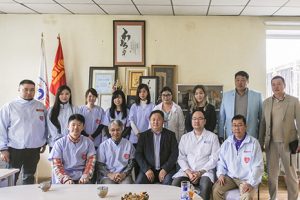
Two medical check up teams were prepared in the National Maternal and Child Health Center in the morning of Aug.8
On the next on August 9, we visited the Central Hospital of the Prefecture at 9 in the morning and started the medical examinations after we had meetings the director of the hospital and other officials. On the first day of the medical examination, 90 people visited the hospital. The medical examination was conducted with two portable echocardiographs brought from Japan and one echocardiograph owned by the hospital.
After the morning medical examination and lunch, we left Arvaikheer City and headed to the next day’s medical check-up location – Khujirt village. It was located about 60 km from Arvaikheer City and it was not a far destination. However, the road was enough off-road driving to make you feel “real Mongolia.” Just before we had arrived, we were presented with another surprise – puncture of the car tire. Our destination Khujirt village is a well-known place in Mongolia for its hot springs and medical institutions that perform spa treatment. I thought it was something similar to the Japanese “hot spring bath”.
On the evening we arrived in Khujirt, we had a good chat with the village mayor and the director of the hospital, where we would conduct medical examination next day while eating Khorkhog (one of the local dishes of Mongolia, where meat and vegetables were cooked with red-hot stone in a pressure cooker). By coincidence, Sodnom CHINZORIG, Minister for Social Welfare and Labor of Mongolia (Ministry of Social Welfare and Labor of Mongolia), who is native from the region, was staying at a camp not far (around one of tough off-road drive) from us. We all had the opportunity to meet with the Minister. I also had the opportunity to explain the purpose, content, and results of the Heart Saving Project and the purpose the medical examinations this time. On the next day, we conducted heart examination on 19 people of the village.
round at 13:00 on August 11, we left the clear sky of Khjirt village and headed to Ulaanbaatar via Kharkhorin City. Again, it was rainy on the way.
Results of the Uvurkhangai medical examination:
Out of 108 people examined, 48 were diagnosed with heart disease and instructed with further treatments.
Khujirt Village:
Out of 19 people examined, 8 were diagnosed with heart disease and instructed with further treatments.
The prefectural hospital in Arvaikheer, where we visited this time, serves as one of the regional central hospitals in Mongolia. Therefore, the facilities and personnel were remarkably able compared to the other regional hospitals that we have visited previously. We were able to use very good quality echocardiography and pediatric probes like never before. In addition, a pediatrician with training history in pediatric cardiology showed a strong interest in echocardiography results that we had and steps and policies that he should take further. He was also present at the patient briefings and provided valuable advices on our coordination with the National Center for Maternal and Child Health and the National Hospital No. 3. It can be said that the cooperation and coordination between medical institutions of local and central area are improving. This has been one of the objectives of our local medical examination project, and we were happy to witness the results and its benefits.
However, physicians and pediatricians who trained in pediatric cardiology are still remains at an inadequate level. Specifically, it was difficult for them to conduct echocardiography by themselves and make in independent evaluation and judgment. As a result, even with the patients that does not require urgency, they generally depended on National Maternal and Child Health Center in the capital and send the patients there.
We advised that valvular disease, which does not cause a problem in childhood, should be kept under the constant watch of cardiologist. Observing all the patients with congenital heart disease at the National Center for Maternal and Child Health would be burdensome both physically and geographically. There is a challenge is to improve and maintain the level of pediatric cardiovascular care in rural areas, but it is likely to take considerable amount of time to resolve it.
The medical clinic in Khujirt village was small in size and had fewer doctors. For this reason, all the children with heart disease were sent to the National Maternal and Child Health Center. The clinic had a new ultrasound device, apparently an aid from Japan, but it did not had a pediatric probe. The overall situation can be concluded that pediatric care itself is not widespread understanding in rural area.
As in the past, we held a joint conference at the end of the medical examination and discussed the further progresses to be taken for the patients we had screened and requested to send the follow-up observation reports to the local doctors. We also expressed our thought that a system easily allowing us to contact the National Maternal and Child Health Center was necessary. We also worked to strengthen our cooperation with the cardiovascular teacher at the National Maternal and Child Health Center. We expressed our opinion that for the patients that require urgent treatment, doctors should contact the National Maternal and Child Health Center or the National Hospital No 3 as soon as possible for the further treatments. Compared to the beginning of our medical examination, the medical situation in Mongolia has clearly improved, and there is no doubt that the cooperation with the central government and the network among doctors are heading to the right direction. However, this medical examination trip reminded me once again that there are still vast areas where medical care is not available.

